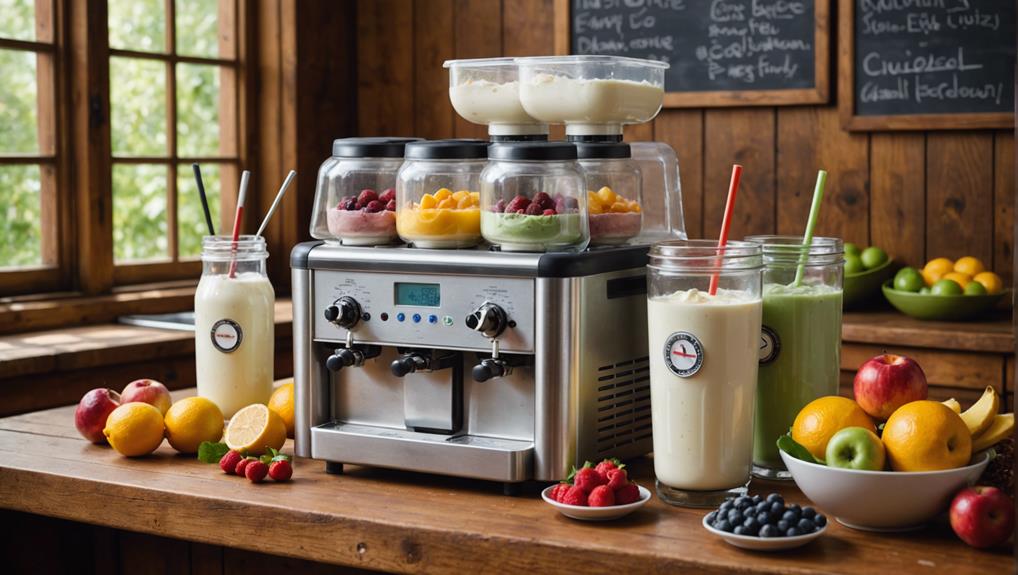Precision in temperature control is essential in frozen yogurt making. Beneficial bacteria thrive in the 37°C to 45°C range, while minimizing ice crystal formation requires freezing temperatures of -4°C to -6°C. Pasteurization at high temperatures eradicates pathogens, ensuring safety and quality. During the cooling and aging phases, maintaining 4°C to 6°C is important for ideal protein hydration and fat crystallization. Homogenization reduces fat globule sizes, enhancing texture and creaminess. Accurate temperature monitoring tools, such as digital thermometers and data loggers, are essential for maintaining control. Understanding these parameters is key to producing high-quality frozen yogurt.
Key Takeaways
- Precise temperature control achieves ideal frozen yogurt texture and consistency.
- Beneficial bacteria thrive between 37°C to 45°C during the fermentation process.
- Freezing temperatures of -4°C to -6°C ensure minimal ice crystal formation.
- Cooling at 4°C to 6°C during aging preserves yogurt quality and flavor.
- Homogenization at controlled temperatures enhances creaminess and mouthfeel.
Importance of Temperature Control

Maintaining precise temperature control is essential for guaranteeing ideal texture, consistency, and overall quality in frozen yogurt production. The stability of the yogurt culture is highly dependent on maintaining ideal temperatures. Beneficial bacteria within the yogurt culture, such as Lactobacillus bulgaricus and Streptococcus thermophilus, thrive at specific temperature ranges, typically between 37°C to 45°C. Deviations from these ideal conditions can hinder bacterial activity, adversely affecting the fermentation process and ultimately the taste and nutritional quality of the frozen yogurt.
Temperature control is also pivotal during the freezing stage. Ice crystal formation, which can lead to undesirable texture, is minimized through rigorous temperature regulation. Maintaining freezing temperatures around -4°C to -6°C ensures a smoother, creamier product by preventing the growth of large ice crystals. Consistent monitoring and adjustments are imperative since even minor fluctuations can compromise the product's structural integrity.
Furthermore, temperature control directly influences the viscosity and mouthfeel of frozen yogurt. Properly managed temperatures result in a uniform, stable mixture, preventing phase separation and ensuring a homogenous product. To summarize, precise temperature control not only optimizes the growth of yogurt cultures but also enhances the overall sensory and textural attributes of frozen yogurt.
Heating and Pasteurization
Maintaining an ideal pasteurization temperature of 195°F (90°C) for 10 minutes is crucial for effective microbial control and enzyme deactivation in frozen yogurt production. Consistent heating time ensures the denaturation of whey proteins, which greatly influences the final texture and thickness. Adherence to precise temperature control protocols not only guarantees safety but also upholds the quality standards of the product.
Optimal Pasteurization Temperature
Reaching the ideal pasteurization temperature of 185°F to 195°F (85°C to 90°C) is essential for effectively eliminating harmful bacteria while preserving the beneficial enzymes necessary for yogurt fermentation in frozen yogurt production. This temperature range ensures that the milk temperature is sufficiently high to promote food safety without compromising the enzymatic activity essential for the development of yogurt cultures.
Achieving and maintaining the precise pasteurization temperature is a vital step in frozen yogurt making. It directly influences the microbial safety and quality of the final product. Accurate temperature control not only reduces the risk of pathogen contamination but also enhances the texture, taste, and shelf-life of the frozen yogurt.
Key considerations for the ideal pasteurization temperature include:
- Microbial Safety: Ensuring the milk temperature reaches the specified range to effectively eliminate harmful bacteria.
- Enzyme Preservation: Maintaining beneficial enzymatic activity necessary for proper yogurt fermentation.
- Product Quality: Enhancing the textural and sensory properties of the frozen yogurt, contributing to a superior consumer experience.
Heating Time Consistency
Maintaining consistent heating time during pasteurization is crucial for effectively eliminating pathogens while preserving the milk's beneficial properties in frozen yogurt production. The standard pasteurization process involves heating milk to approximately 185°F (85°C) for a defined duration. This precise control of temperature and heating time is vital to eradicate harmful bacteria without compromising the milk's nutritional value.
Data indicates that deviations in heating time can lead to suboptimal pasteurization. Insufficient heating time may fail to eliminate all pathogens, posing a food safety risk. Conversely, excessive heating time can result in protein denaturation, adversely affecting the texture and flavor profile of the final frozen yogurt product. Therefore, maintaining a strict adherence to the recommended heating parameters ensures both safety and quality.
The precision in controlling heating time is achieved through automated pasteurization systems that monitor and regulate the temperature continuously. These systems are calibrated to maintain the exact heating duration required, thereby ensuring consistency across production batches. Adhering to these parameters not only ensures compliance with food safety regulations but also enhances the overall sensory attributes of the frozen yogurt, delivering a consistently high-quality product to consumers.
Safety and Quality Assurance
Adherence to precise temperature control during pasteurization not only eradicates harmful bacteria but also guarantees the frozen yogurt maintains its best quality and safety standards. In frozen yogurt production, pasteurization involves heating milk to 195°F, a critical step for ensuring both microbial safety and product integrity. This high-temperature treatment effectively annihilates pathogenic microorganisms, thereby preventing potential health hazards.
Proper temperature control is paramount in achieving consistent pasteurization results. Deviations from the specified 195°F can lead to suboptimal bacterial eradication or degrade the milk's nutritional and sensory properties, compromising both safety and quality. Consistent temperature regulation also plays a vital role in extending the shelf life of the final product, as effective pasteurization minimizes spoilage risks.
Maintaining stringent temperature guidelines is essential for compliance with food safety standards and regulations. Regulatory bodies mandate specific pasteurization protocols to safeguard public health, making adherence non-negotiable for producers.
- Microbial Safety: Ensures the elimination of harmful bacteria.
- Quality Assurance: Maintains the nutritional and sensory qualities of yogurt.
- Regulatory Compliance: Meets statutory food safety standards and guidelines.
Cooling and Aging Stages

Precise temperature control during the cooling and aging stages is crucial to enhance the viscosity and texture of frozen yogurt. In these stages, the temperature is methodically lowered to allow the product to set correctly, achieving a smooth and consistent texture. Empirical data underscores that maintaining a recommended temperature range, typically between 4°C to 6°C, during the aging process is vital. This controlled environment facilitates the crystallization of fats and the hydration of proteins, which are essential for the desired mouthfeel and stability of the final product.
The cooling stage, immediately following pasteurization, rapidly lowers the temperature to inhibit microbial growth and preserve the yogurt's quality. Subsequently, the aging stage allows the mixture to rest at a controlled low temperature, which can last from four to twelve hours. This period is not merely a passive phase; it is a critical window where flavors mature and meld, and the intricate balance of ingredients reaches its peak potential. Monitoring and adjusting the temperature during these stages ensures that the viscosity is improved and flavors are fully developed, resulting in premium frozen yogurt. Precision-focused temperature control during these phases is non-negotiable for producing high-quality frozen yogurt.
Homogenization Process
In the homogenization process, reducing the fat globule size to sub-micron levels is essential for achieving a uniformly distributed fat phase within the frozen yogurt mix. This uniform distribution not only enhances the product's mouthfeel but also contributes greatly to the creaminess and overall texture. Precision in controlling homogenization parameters guarantees the production of high-quality frozen yogurt with consistent texture and appearance.
Particle Size Reduction
How does the homogenization process effectively reduce fat globule size to enhance the texture and mouthfeel of frozen yogurt? Homogenization plays a vital role in the production of frozen yogurt by breaking down fat globules into smaller, uniformly-sized particles. This process is essential for improving the texture and mouthfeel of the final product. By reducing the size of fat globules, the homogenization process guarantees a smoother, creamier consistency, which is highly desirable in frozen yogurt.
The homogenization process involves subjecting the yogurt mix to high pressure, which disperses the fat globules evenly throughout the mixture. This results in enhanced stability and consistency, preventing the separation of fat and liquid. Controlled homogenization is crucial to achieving an ideal balance, as over-homogenization can lead to undesirable textural changes.
- Improved Texture: Smaller fat globules contribute to a smoother, creamier texture in frozen yogurt.
- Enhanced Mouthfeel: Reduced particle size results in a more pleasant and creamy mouthfeel.
- Stability and Consistency: Uniformly sized fat particles enhance the stability and consistency of the frozen yogurt mix.
Uniform Ingredient Distribution
The homogenization process in frozen yogurt production guarantees the uniform distribution of ingredients, such as milkfat and milk solids, by utilizing high-pressure systems to create a stable and consistent emulsion. This critical step involves the application of high-pressure homogenizers, which effectively break down fat globules into smaller, uniformly sized particles. Consequently, this facilitates an even ingredient distribution, thereby preventing separation and ensuring a consistent product profile.
Data indicates that proper homogenization not only stabilizes the emulsion but also plays a vital role in the overall texture and mouthfeel of the frozen yogurt. By reducing the size of milkfat globules, the process minimizes creaming and sedimentation issues, leading to an enhanced homogeneity of the final product. The consistency achieved through homogenization is paramount for maintaining the structural integrity and sensory attributes of frozen yogurt.
Technical parameters such as pressure levels, typically ranging from 2,000 to 10,000 psi, are carefully controlled to achieve the best ingredient distribution. Precision in these settings is crucial, as variations can directly impact the quality and stability of the frozen yogurt. Consistent homogenization ensures that each batch of frozen yogurt meets stringent quality standards, providing consumers with a reliably smooth and well-integrated product.
Creamier Texture Achieved
Achieving a creamier texture in frozen yogurt production hinges on reducing fat globule size through the homogenization process. By minimizing the size of fat globules, homogenization greatly enhances the mouthfeel, delivering a smoother, creamier texture that meets consumer expectations. This process is essential for uniformly distributing fat throughout the frozen yogurt mix, thereby ensuring consistency in texture.
The homogenization process not only improves the texture but also plays an important role in temperature stability, which is critical in maintaining the quality of frozen yogurt. Controlled homogenization at ideal temperature settings prevents phase separation and enhances the product's overall stability and creaminess.
Key aspects of the homogenization process include:
- Fat globule size reduction: Smaller fat globules contribute to a finer texture and improved mouthfeel.
- Uniform fat distribution: Even fat dispersion ensures consistent texture and prevents separation.
- Temperature control: Maintaining specific temperature ranges during homogenization is essential for achieving desired textural outcomes.
To summarize, the homogenization process is a linchpin in frozen yogurt manufacturing, delivering a creamier texture by ensuring fine fat dispersion and temperature-controlled processing conditions. This, in turn, elevates the sensory attributes and overall quality of the final product.
Inoculation With Yogurt Culture

Inoculation with yogurt culture involves introducing specific strains of beneficial bacteria, such as Lactobacillus and Streptococcus, to initiate the fermentation process essential for producing high-quality frozen yogurt. This inoculation step is pivotal as it sets the stage for the metabolic activities that convert lactose in milk to lactic acid, imparting the characteristic tangy flavor to the final product.
The selected yogurt culture added during inoculation ensures the growth of probiotic bacteria, which not only contribute to the health benefits of frozen yogurt but also play an essential role in achieving the desired texture and consistency. Precise temperature control during this phase is paramount. Typically, the inoculated mix is incubated at temperatures ranging from 37°C to 45°C, which optimizes bacterial proliferation and activity.
Accurate monitoring of these environmental conditions is critical, as deviations can have a significant impact on the efficiency of fermentation. This controlled bacterial activity transforms the milk mixture into a semi-solid form, primed for the subsequent stages of production. The efficacy of this inoculation phase determines the overall quality, flavor profile, and probiotic content of the frozen yogurt, underscoring its importance in the production pipeline.
Freezing Process
Maintaining the freezing process at a controlled temperature of approximately -4°F (-20°C) is essential to preserving the creamy texture of frozen yogurt. This critical temperature management guarantees that the formation of ice crystals is minimized, which directly impacts the mouthfeel and overall quality of the final product. The freezing process must be rapid and consistent to produce smaller ice crystals, resulting in a smoother texture that is highly desirable in yogurt making.
Rapid freezing techniques are preferred, as they prevent the formation of large ice crystals that can impart a gritty texture to the frozen yogurt. This is achieved by maintaining a stable, low temperature throughout the freezing process, thereby ensuring that the yogurt mixture quickly solidifies without compromising its structural integrity.
- Ice crystal formation: Smaller ice crystals are achieved through rapid freezing, enhancing the smooth texture.
- Temperature consistency: Maintaining -4°F (-20°C) prevents the development of large ice crystals.
- Quality control: Consistent freezing temperatures ensure high-quality frozen yogurt.
Precision in temperature control during the freezing process is paramount in yogurt making, as it directly influences the sensory attributes and consumer acceptance of the final product. By adhering to these strict temperature guidelines, manufacturers can consistently produce superior frozen yogurt with excellent texture and taste.
Hardening Stage

The hardening stage in frozen yogurt making requires maintaining the mixture at temperatures ranging from -4°F to -20°F (-20°C to -29°C) to guarantee ideal texture and structural integrity. This phase is critical for ensuring that the frozen yogurt sets correctly, maintaining a smooth and creamy texture. Precise temperature control during hardening helps prevent the formation of large ice crystals, which can compromise the product's quality and mouthfeel.
The hardening stage greatly impacts the structural stability of frozen yogurt. Maintaining the mixture at the specified temperature range during this stage ensures excellent consistency and firmness, which are essential for both consumer satisfaction and ease of packaging and distribution. The duration of the hardening process may vary depending on the type of frozen yogurt and the specific freezing equipment utilized.
Data-driven monitoring of the hardening stage is essential to achieve the desired product characteristics. It ensures that the frozen yogurt reaches the appropriate firmness and texture before it proceeds to packaging. Proper temperature control during this stage not only enhances the sensory attributes of the final product but also extends its shelf life by maintaining consistent quality.
Temperature Monitoring Tools
Accurate temperature monitoring tools are essential for ensuring precise control throughout the frozen yogurt production process. The utilization of high-precision instruments such as digital thermometers and infrared thermometers facilitates meticulous temperature management, necessary for maintaining product consistency and quality.
Digital thermometers offer real-time, accurate readings important for monitoring the temperature of yogurt mixtures during various stages of production. These devices are indispensable for ensuring the mixture remains within the ideal temperature range for both fermentation and freezing. Infrared thermometers are particularly advantageous for their non-contact measurement capabilities, allowing for quick and efficient surface temperature checks without the risk of contamination.
Moreover, temperature data loggers play a pivotal role in tracking temperature variations over extended periods. By recording temperature data continuously, these devices enable producers to identify and rectify any deviations from the set parameters promptly.
Regular calibration of these temperature monitoring tools is essential to guarantee their accuracy and reliability. Without proper calibration, the risk of inconsistent product quality increases, which can compromise the frozen yogurt's texture and taste.
Key temperature monitoring tools include:
- Digital thermometers: Provide accurate real-time readings.
- Infrared thermometers: Enable quick surface temperature checks.
- Temperature data loggers: Track temperature variations over time.
Common Temperature Issues

Fluctuating temperatures during the fermentation and freezing stages can greatly compromise the texture and quality of frozen yogurt. Precise temperature control is essential to avoid common texture issues such as iciness, graininess, and improper consistency. During fermentation, inconsistent temperatures can disrupt the development of the yogurt cultures, leading to a substandard base for freezing.
| Temperature Stage | Common Issue |
|---|---|
| Fermentation – High | Runny consistency |
| Fermentation – Low | Poor culture growth |
| Freezing – High | Soft, runny texture |
| Freezing – Low | Hard, difficult to scoop |
| General Fluctuations | Icy, grainy texture |
Freezing yogurt at excessively high temperatures results in a product that is too soft and lacks structural integrity, while freezing at temperatures that are too low can yield a product that is overly hard and challenging to serve. Proper temperature control during both stages ensures a smooth, creamy texture and best taste in the final frozen yogurt product. Therefore, monitoring and maintaining consistent temperatures is not just advisable but critical for achieving the desired quality in frozen yogurt. Failure to adhere to stringent temperature control can result in significant texture issues, adversely affecting the product's marketability and consumer satisfaction.
Frequently Asked Questions
What Temperature Should Frozen Yogurt Be?
Frozen yogurt should be stored between -5°F to -20°F to maintain texture quality and flavor consistency. The best serving temperature ranges from 16°F to 20°F, ensuring top-notch texture and taste.
What Is the Best Temperature for Yogurt Making?
Like a fine-tuned instrument, the perfect temperature for yogurt making is 110-115°F (43-46°C). This range guarantees a precise fermentation process, utilizes effective heating techniques, and complements the milk selection for ideal texture and flavor.
What Temp Kills Yogurt Starter?
Yogurt starter cultures are killed by heat exposure at temperatures above 120°F/49°C, with complete destruction occurring at 140°F/60°C. Maintaining ideal yogurt fermentation necessitates careful control of temperature to preserve starter cultures' viability.
What Temperature Kills Probiotics in Yogurt?
'A stitch in time saves nine.' Probiotic strains in yogurt exhibit thermal tolerance up to 104°F (40°C). Exceeding 120°F (49°C) markedly diminishes bacterial viability, with extended exposure above 140°F (60°C) being particularly detrimental.
Conclusion
In summation, meticulous temperature management in frozen yogurt production is paramount to ensuring product quality and safety. From pasteurization, which eradicates pathogenic microorganisms, to the hardening stage, which solidifies the final product, each phase demands exacting thermal precision. Employing advanced temperature monitoring tools mitigates common issues such as crystallization and bacterial contamination, ensuring consistency and consumer safety. The efficacy of these processes is reminiscent of a well-calibrated chronometer, where precision dictates the success of the final product.







